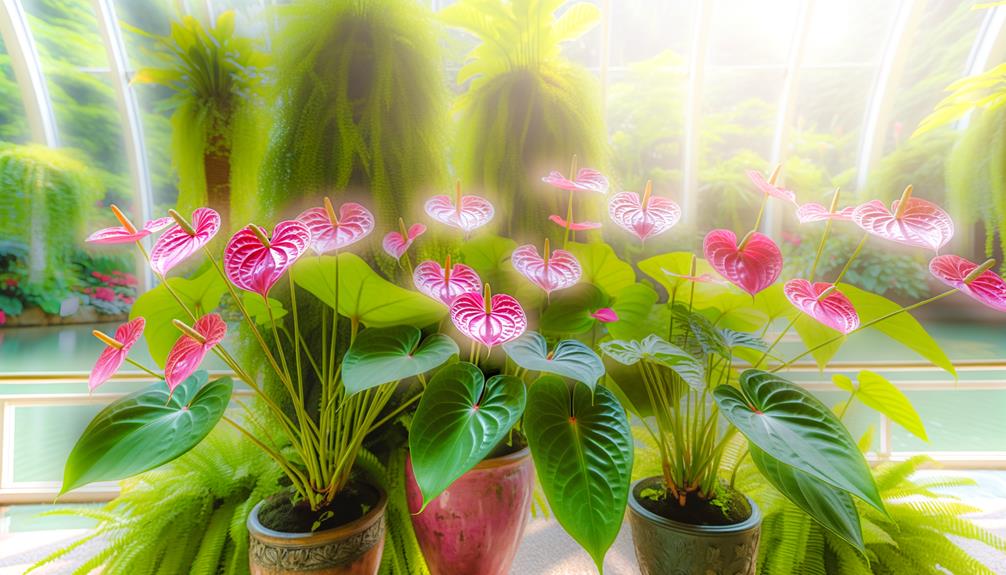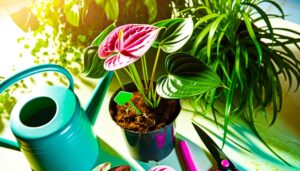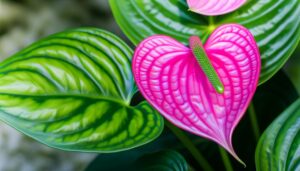How to Thrive With Anthurium Pink Explosion Plants: 10 Essential Tips
To guarantee your Anthurium Pink Explosion plant thrives, place it in bright, indirect sunlight and avoid direct exposure. Keep the soil consistently damp but not waterlogged; water when the top inch feels dry.
Employ a well-aerated, rich organic soil mix with slightly acidic to neutral pH. Maintain 70-80% relative humidity and a stable temperature range of 65-80°F.
Regularly prune yellowing or dead leaves, and inspect for pests, using insecticidal soap if needed. Ensure proper drainage when repotting, positioning the root ball correctly.
These essential tips will help your plant flourish, and there's even more to take into account on your journey to optimal care.

Key Takeaways
- Place Anthurium Pink Explosion in bright, indirect sunlight, avoiding direct sun exposure.
- Maintain soil consistently damp, watering when the top inch feels dry.
- Use a well-aerated, rich organic soil mix to ensure proper drainage.
- Keep humidity levels between 70-80% and avoid misting the leaves directly.
- Fertilize with a balanced, water-soluble fertilizer, diluted to avoid root burn.
Optimal Lighting
To ensure your Anthurium Pink Explosion thrives, position it in bright, indirect sunlight to mimic its natural tropical habitat. Direct sunlight can scorch its delicate leaves, leading to photodamage and chlorosis. Instead, place it near an east or north-facing window where it can receive diffused light.
If you notice etiolation—where the plant stretches and becomes leggy—it's a sign of insufficient lighting. Consider supplementing with fluorescent or LED grow lights, ensuring a light intensity of 10,000 to 20,000 lux. Rotate the plant periodically to encourage symmetrical growth and prevent phototropism.
Proper Watering
To maximize the growth of your Anthurium Pink Explosion plants, maintain ideal soil moisture by keeping the soil consistently damp but not waterlogged.
You should water them when the top inch of soil feels dry, which typically means every 5-7 days.
Monitor humidity levels and adjust your watering frequency accordingly to prevent root rot.
Optimal Soil Moisture
Maintaining perfect soil moisture for Anthurium Pink Explosion plants involves ensuring the soil remains consistently damp but not waterlogged. This can be achieved through regular but moderate watering intervals. You'll want to check the soil's moisture level using your finger or a moisture meter. Aim for a balance where the top inch of the soil feels slightly moist.
Excess water can lead to root rot, so make sure your pot has sufficient drainage. Use a well-aerated, rich organic soil mix to promote ideal moisture retention and prevent compaction. This strategy provides an excellent environment for the plant's roots, fostering healthy growth.
Watering Frequency Guide
When managing the watering frequency for Anthurium Pink Explosion plants, aim to water them every 5-7 days during the growing season, adjusting based on environmental conditions and soil moisture levels. Utilize a moisture meter to ensure accurate watering needs. Overwatering can lead to root rot, while underwatering stresses the plant, hindering growth. Here's a quick guide:
| Condition | Action Needed | Frequency |
|---|---|---|
| Dry topsoil | Water thoroughly | Every 5 days |
| Humid environment | Reduce watering | Every 7 days |
| Soggy soil | Hold off on watering | Check in 2 days |
| Moderate moisture | Maintain current schedule | Every 6 days |
Monitor the plant's response and adjust your routine accordingly. Precision and consistency promote a thriving Anthurium Pink Explosion.
Ideal Soil Mix
For Anthurium Pink Explosion plants, you'll need a soil mix that prioritizes drainage and aeration to prevent root rot. Incorporate nutrient-rich components like orchid bark, peat moss, and perlite to guarantee a balanced nutrient profile.
Additionally, maintain a slightly acidic to neutral pH level, ideally between 5.5 and 6.5, to optimize nutrient uptake.
Drainage and Aeration Importance
Proper drainage and aeration are crucial for Anthurium Pink Explosion plants, requiring a soil blend that includes elements like perlite, orchid bark, and peat moss. This blend guarantees water percolates effectively, preventing root rot and facilitating healthy gas exchange. You'll want to aim for a well-balanced mix to achieve the right balance.
Here's a breakdown of an ideal blend:
| Component | Proportion | Advantages |
|---|---|---|
| Perlite | 30% | Improves drainage, aeration |
| Orchid Bark | 40% | Offers structure, aeration |
| Peat Moss | 30% | Preserves moisture, supplies nutrients |
Nutrient-Rich Soil Components
To ensure your Anthurium Pink Explosion plants receive the best nutrients, incorporate a soil mix enriched with organic matter like compost or worm castings. These materials provide essential minerals and enhance soil fertility. Opt for a well-draining potting mix that combines equal parts of orchid bark, perlite, and peat moss. This blend guarantees optimal aeration and moisture retention, promoting robust root development.
Integrating activated charcoal can further improve soil structure and detoxify harmful substances. Regularly amending the soil with slow-release fertilizers ensures a steady nutrient supply. Remember, a nutrient-dense medium is essential for vibrant foliage and prolific blooms.
Your Anthurium's health hinges on the careful selection and maintenance of its soil composition.
Ph Level Balance
Maintaining the soil's pH level between 5.5 and 6.5 is crucial for optimal nutrient absorption in Anthurium Pink Explosion plants. You'll need to monitor this closely using a pH meter or test strips.
Adjust the pH by incorporating sulfur to lower it or lime to raise it. Utilize a well-draining soil mix with components like peat moss, perlite, and orchid bark. These elements guarantee proper aeration and moisture retention while maintaining pH stability.
Regularly check pH levels, especially after watering or fertilizing, as these activities can modify the soil's acidity. Remember, consistent pH monitoring and adjustments will encourage healthier root systems and vibrant blooms, safeguarding your Anthurium Pink Explosions thrive.
Humidity Requirements
Ensuring ideal humidity levels is essential for the strong growth of Anthurium Pink Explosion plants. Aim for a relative humidity of 70-80%. You can use a hygrometer to monitor levels. If your environment is too dry, consider using a humidifier or placing a tray of water near the plant. Grouping plants together can also increase local humidity through transpiration. Avoid misting leaves directly; instead, focus on ambient moisture levels.
| Humidity Level | Action Required | Tools Needed |
|---|---|---|
| 60% or lower | Increase humidity | Humidifier, water tray |
| 60-70% | Maintain current level | Hygrometer |
| 70-80% | Optimum range | Regular monitoring |
| Above 80% | Reduce humidity | Ventilation, dehumidifier |
Maintain a balance to prevent fungal issues while promoting lush growth.
Temperature Guidelines
You must maintain an ideal temperature range of 65-80°F for Anthurium Pink Explosion plants to thrive.
Avoid exposing them to sudden temperature fluctuations, as this can stress the plant and hinder growth.
During seasonal temperature changes, consider adjusting indoor climates to keep conditions stable.
Ideal Temperature Range
For thriving growth, Anthurium Pink Explosion plants require a temperature range between 65°F and 80°F. Maintaining this range promotes ideal photosynthesis and metabolic activities.
You'll find that temperatures below 65°F can slow down growth, while exceeding 80°F may stress the plant, affecting its vibrant blooms.
Ensure your indoor environment mimics tropical conditions by placing your Anthurium in a warm spot, away from cold drafts and direct heat sources. Consider using a digital thermometer to monitor room temperature.
Remember, consistency is key; sudden shifts can be detrimental. If you're using an HVAC system, make adjustments to keep the ambient temperature stable.
Avoiding Temperature Fluctuations
Maintaining a consistent temperature range is essential for the finest health of Anthurium Pink Explosion plants. Fluctuations can lead to stress and hinder growth. Aim for a stable environment between 65°F and 75°F (18°C to 24°C).
Sudden drops or spikes can cause cellular damage, leading to browning leaves and stunted development. Avoid placing your plants near drafts, air conditioning vents, or heaters. Use a digital thermometer to monitor room temperature regularly.
If you notice deviations, adjust immediately to maintain equilibrium. Insulate windows in winter and use fans for a gentle airflow in summer. By controlling these variables, you'll create a prime microclimate that fosters robust growth and vibrant blooms, ensuring your Anthurium Pink Explosion thrives.
Seasonal Temperature Adjustments
Although maintaining a stable temperature is important, adapting your care techniques to seasonal changes is equally essential for Anthurium Pink Explosion plants.
During winter, aim to keep temperatures between 60-65°F (15-18°C) to prevent stress. Avoid cold drafts and optimize the plant doesn't sit near frosty windows.
In summer, ideal temperatures range from 70-85°F (21-29°C). High humidity levels are vital, so mist the leaves regularly or use a humidifier. Rapid temperature shifts can lead to growth stagnation or leaf drop, so gradually acclimate your plant to any changes.
Monitor your indoor climate closely, and you'll find your Anthurium thriving all year round. Remember, slight adjustments make significant variances in the plant's health and vibrancy.
Fertilization Tips
To maximize the nutrients for your Anthurium Pink Explosion plants, apply a balanced, water-soluble fertilizer every four to six weeks during the growing season. Choose a formulation with an equal ratio of nitrogen, phosphorus, and potassium (such as 10-10-10 or 20-20-20). Dilute the fertilizer to half the recommended strength to avoid root burn, ensuring ideal nutrient absorption.
Monitor the pH levels of your soil; Anthuriums prefer slightly acidic conditions, around 5.5 to 6.5. Regularly check for signs of nutrient deficiencies, like yellowing leaves or stunted growth, and adjust your fertilization regimen accordingly.
Don't fertilize during dormancy, as the plant's uptake of nutrients significantly decreases, which can lead to nutrient build-up and potential toxicity.
Pruning Techniques
Pruning your Anthurium Pink Explosion plants is crucial for promoting healthy growth and preventing disease. Start by sterilizing your pruning shears with isopropyl alcohol to avoid pathogen transfer.
Trim away any yellowing or dead leaves at the base, as they can harbor bacteria and fungi. Focus on cutting back leggy stems to encourage bushier growth. Make clean, diagonal cuts just above a leaf node to stimulate new growth.
Don't forget to remove spent flowers to direct the plant's energy toward foliage and new blooms. Regularly inspect your plant and prune as needed, ideally every few months.
Pest Control
Keeping your Anthurium Pink Explosion plants healthy involves vigilant pest control to prevent infestations from common pests like aphids, spider mites, and mealybugs. Inspect your plants regularly, focusing on leaf undersides and new growth where pests often hide. Use a magnifying glass for precise examination.
If you spot pests, an insecticidal soap solution is effective. Mix 1 teaspoon of mild liquid soap with 1 quart of water, then spray thoroughly. For severe infestations, consider neem oil or a horticultural oil, as these disrupt pest reproduction.
Maintain good airflow and avoid overwatering, as high humidity and stagnant air can exacerbate pest problems. Remember, early detection and consistent treatment are essential for keeping your plants vibrant and pest-free.
Repotting Advice
When repotting your Anthurium Pink Explosion, make sure the new pot is only slightly larger to prevent waterlogging and root rot. Choose a pot with excellent drainage and use a well-aerated, coarse growing medium, like a blend of orchid bark, perlite, and peat moss. Gently remove the plant from its current pot, taking care not to damage the roots. Shake off excess soil, and trim any damaged or decaying roots with sterilized scissors.
Position your Anthurium so that the root ball is centered and at the same depth as before. Gradually fill in around the roots with the fresh medium, lightly pressing to eliminate air pockets. Water thoroughly but make certain excess water drains out, maintaining ideal moisture levels.
Common Problems
After repotting, you might encounter common problems like yellowing leaves, pest infestations, or stunted growth in your Anthurium Pink Explosion.
Yellowing leaves often indicate chlorosis, typically caused by improper light or nutrient deficiencies. Guarantee your plant receives bright, indirect light and balanced fertilization.
Pest infestations, such as spider mites or aphids, can be managed with neem oil or insecticidal soap.
Stunted growth may result from root binding or inadequate watering practices. Check that roots have space to expand and maintain consistent moisture levels without waterlogging.
Regularly inspect your plant for signs of distress and address issues promptly to maintain its vibrant health.
Conclusion
With these 10 essential tips, you'll see your Anthurium Pink Explosion plants flourish like never before.
Remember, the devil's in the details: best lighting, precise watering, and perfect soil mix are your keys to success.
Maintain the right humidity, temperature, and pruning techniques to keep your plants in prime condition.
Stay vigilant against pests, repot when necessary, and address issues promptly.
By following these guidelines, you'll cultivate a thriving botanical masterpiece in your home.






